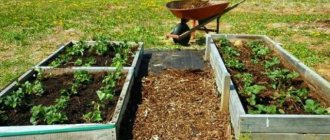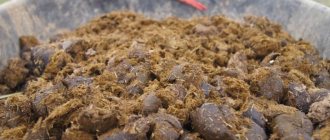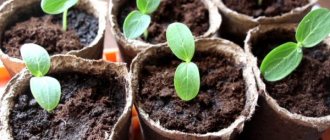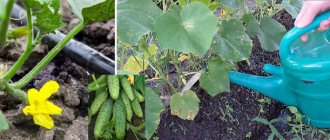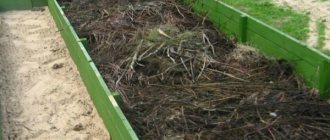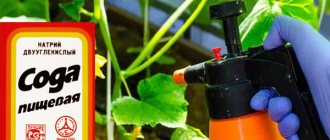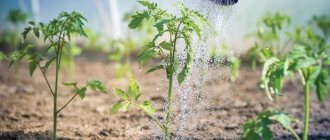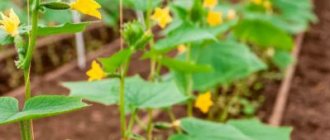The need to feed greenhouse cucumbers
Cucumbers are successfully grown both in street beds and in greenhouses and greenhouses (including polycarbonate ones). In closed ground, the crop is provided with optimal climatic conditions for vegetation, but the owner of the garden is solely responsible for the supply of nutrients. Plants require various micro- and macroelements at different phases of vegetative development (rooting, growth, growth of green mass, flowering, fruiting).
The root system, located close to the surface, cannot independently obtain the necessary nutrition from the depths. Feeding cucumbers in a greenhouse allows you to provide the crop with everything it needs, as well as increase its immunity to diseases. This operation must be performed at all stages of growing cucumbers: from planting seeds to the stage of harvesting fruits.
Two methods are used to apply fertilizers:
- Under the root. Nutrient compositions are applied to the soil in dry form, but most often solutions based on organic and mineral components are pre-prepared; a watering can is required to fertilize the plantings. Before carrying out the procedure, it is necessary to moisten the soil around the bushes, which ensures better absorption of the applied substances.
- Foliar (additional). The foliage of plants is sprayed with nutrient solutions. For these purposes, you can use any type of sprayer. You need to feed cucumbers early in the morning or in the evening. Example of fertilizer compositions: 10 g wood ash/1 liter of water, 1 tsp. boric acid + 10 crystals of potassium permanganate / 1 liter of water.
Foliar feeding, despite its effectiveness and speed, cannot replace the application of fertilizers to the soil.
Types of feeding
Based on the method of administration, there are root and foliar fertilizers for cucumbers.
Root
This type of feeding is practiced when unfavorable conditions occur, for example, low temperatures. There are primary and secondary:
- Primary. Produced after the appearance of the 3rd leaf. For 1 sq. m in 10 liters of water, dissolve 3-8 g of potassium chloride and 10-15 g of superphosphate and add them to the grooves 3-5 cm deep. The grooves are made at a distance of 7 cm from the plant.
- Secondary. It is carried out with the same composition after a month, but the grooves are already made 10-12 cm deep, and retreat from the plant by 10-15 cm.
Foliar
Foliar feeding consists of spraying the leaves with useful compounds. For this use:
- 10 g superphosphate, 1 g boric acid, 30 g potassium nitric, 0.4 g manganese sulphate, 0.1 g zinc sulfate;
- 1 tsp. boric acid, 10-12 crystals of potassium permanganate per 1 liter of water.
Although foliar feeding has a quick effect, it cannot fully provide the plant with everything it needs.
Types of fertilizers used when growing cucumbers in a greenhouse
The types of fertilizers required for vegetable crops vary depending on the stage of vegetative development, the type of soil and the requirements of the variety being grown.
If cucumbers do not grow well in a greenhouse: how to feed the plants:
Mineral supplements
The main elements that cucumbers require when growing them are nitrogen, potassium and phosphorus.
What are these fertilizers for?
- Without nitrogen, any plants cannot develop normally. The element is necessary for the growing season in any period; it is needed for metabolism and the formation of green mass.
- Potassium is important for stimulating photosynthesis, increasing the rate of protein-carbohydrate metabolism and countering external adverse factors.
- Phosphorus is required for metabolism, stimulating the development of the root system, accelerating the process of fruit formation and increasing their number.
These substances can be applied separately or be part of complex fertilizers.
Also required for the development of culture are: calcium, copper, boron, iron and other elements.
The most common types of chemicals used to fertilize cucumbers:
- Potassium: potassium chloride and sulfate, potassium salt, potassium nitrate.
- Nitrogen: urea, ammonium nitrate.
- Phosphoric: superphosphate, orthophosphate.
Today, manufacturers offer phosphorus-potassium, nitrogen-phosphorus, nitrogen-potassium, as well as complexes containing all the most important components for cucumbers. They are available in both powder and liquid form. For example, nitroammophoska contains nitrogen and phosphorus, as well as some other elements. The main components of potassium phosphate are K and P.
The most popular compositions for fertilizing cucumbers:
- 10 g of ammonium nitrate, potassium salt and superphosphate per bucket of water;
- 20 g of superphosphate, urea, potassium sulfate per 10 liters of water.
Organic fertilizers
Such fertilizing is perfectly absorbed by cucumbers and helps to obtain a decent harvest.
How can you feed cucumbers grown in a greenhouse:
- Compost.
This substrate is obtained after the decomposition of various types of organic matter: plant residues, mowed grass, household waste, etc. The nutrient mixture is formed as a result of natural decay (with the participation of microorganisms) and the influence of worms and insects. The speed of composting depends on the temperature and humidity of the environment, as well as the access of air to the rotting raw materials. Without the use of process accelerators, fertilizer (soil mixture) enriched with nitrogen, potassium and phosphorus can be obtained approximately two years after planting.
What is good about compost:
- it is environmentally friendly;
- contains a large number of micro- and macroelements;
- can be applied in any quantity to the soil.
- To obtain fertilizer, no financial investment is required, which can also be considered its advantage. Compost is placed in the holes before planting the plant or applied under it during the process of growth and development.
- Manure
.
Of the fertilizers that are excrement of farm animals, the most popular are mullein and bird droppings.
Using manure as a top dressing allows you to:
- saturate the soil with the necessary elements;
- improve the physical and mechanical characteristics of the earth;
- activate microflora;
- increase the absorption of mineral fertilizers by plants;
- saturate the soil with carbon dioxide.
Fresh manure is not recommended for fertilizing plants, as it can harm them due to its high toxicity. It can be used if there is no direct contact with the crop, for example, to warm the soil or to add it to the ground during the autumn digging of beds. Rotted manure is more suitable as a top dressing, as it perfectly restores soil fertility.
To apply under cucumbers, prepare solutions: chicken manure is diluted with water in a ratio of 1:15, cow manure - 1:6. It is recommended to infuse the compositions for a week. Before applying under the bush, you should dilute them with water (for 1 liter of solution you need 2 liters of water).
- Peat.
Despite the rather low content of nutritional components, this fertilizer improves the soil structure well. The most nutritious is lowland peat. To increase the fertility of the land, you need to add 5...10 kg of peat per 1 m2. In a greenhouse, peat retains its characteristics for about 2-3 years.
You can also use other types of organic matter as fertilizers: wood ash, sawdust, silt, etc.
How often should you feed cucumbers in a greenhouse?
So, to summarize, you need to feed cucumbers in a greenhouse at least 4-5 times.
The first feeding is carried out two weeks after planting the seedlings, the main elements are potassium and nitrogen. The second feeding is organized at the beginning of flowering. In addition to potassium and nitrogen, cucumbers at this time need magnesium, boron and other trace elements. The third feeding coincides with the beginning of fruiting. The composition and proportions of the applied substances are identical to the second feeding, but some of them can be adjusted depending on the condition of the plants. The fourth feeding is carried out 2-3 weeks after the third and is aimed at stimulating fruiting. Phosphorus must be added to the regular fertilizer composition. If necessary and in growing conditions on depleted soil, a fifth fertilizing is carried out - with complex fertilizer, based on the information in the instructions for it.
Caring for greenhouse and greenhouse cucumbers is not as easy as it might seem at first glance. But all mineral, organic and other “investments” will pay off with a rich and tasty harvest of this crop.
Fertilizing cucumbers during flowering and fruiting
When mass flowering of plantings begins (at the end of May), vegetables require more nutrients.
The following combination of fertilizers can be used as top dressing:
- diluted cow manure (500 ml);
- nitrophoska (1 tbsp);
- wood ash (1 tbsp.);
- boric acid (0.5 g);
- manganese sulfate (0.3 g).
These components are diluted in a bucket of water and mixed thoroughly. For 1 sq.m. beds require about 3 liters of composition.
At the fruiting stage, cucumbers also need additional feeding. To do this, you can use: ash diluted in water in a ratio (1:5), potassium nitrate (25 g/10 l of water), a solution of cow manure (in a ratio of 1:5).
Types of nitrogen fertilizers and rules for their use
When there are not enough nutrients in the soil, the plants are fertilized. The procedure usually begins at the stage of foliage development. At the very beginning, cucumber seedlings have enough nitrogen. They grow green mass well, but over time the seedlings will begin to stretch out and the leaves will turn yellow. Need feeding. And here, first of all, it is worth considering what fertilizer to use.
There are 3 types of nitrogen fertilizers: ammonia, nitrate, amide. Each of them is used at a certain stage of cucumber development. Fertilizers are produced in liquid form and granules or powder.
Calcium nitrate
Nitrate types of nitrogen fertilizer include calcium and sodium nitrate. These alkaline compounds are useful for adding to soils with high acidity. Nitrogen will be well absorbed.
See also
How to properly tie cucumbers on the balcony, diagram for home conditions
Read
Calcium nitrate contains 15% nitrogen. The fertilizer is valued for its high hygroscopicity. Fertilizer is used when green plants become lethargic and leaves droop. It is useful to add saltpeter to the soil before planting cucumbers. The mixture will help prevent the development of diseases and strengthen the root system of vegetable plants. Seedlings will sprout faster if you fertilize the soil with calcium nitrate.
The scheme for fertilizing cucumbers with fertilizer is as follows:
- When 3 true leaves appear, the seedlings are sprayed with a solution prepared from 1 tablespoon of saltpeter per 6 liters of water.
- The second time is processed after 14 days.
- Third spraying in a month.
The procedure is carried out in cloudy weather, in the absence of wind.
Peat
Gardeners view peat as a nitrogen fertilizer in two ways. It contains nitrogen in a poorly digestible form. Peat is useful for making clay soils permeable to moisture and air.
It is better to feed cucumbers with peat compost. Sawdust and peat are placed at the bottom of the container or enclosed area, and plant debris and food waste are placed on top. On top there is peat again, mixed with garden soil. It is advisable to spill the mixture with slurry. After 1-2 years of rotting, they will receive an excellent fertilizer for cucumbers.
Urea
Organic fertilizer contains more than 47% nitrogen. The granules are used by embedding into the soil of a cucumber bed. It is not recommended to leave it in the air, as there will be a “leakage” of useful gas. It is better to water the plants with a urea solution. 45 grams of urea are dissolved in a bucket of clean water. You can also use the mixture as a foliar feeding, spraying the leaves and stems of the vegetable.
Ammonium nitrate
Fertilizer is produced in the form of powder or granules that dissolve well in water. Nitrate is used at different stages of the vegetable growing season. Prepare the solution as follows: place 3 tablespoons of ammonium in 10 liters of water, stir until completely dissolved. Water the prepared liquid at the root of the bushes. In dry form, distribute 5 grams of powder or granules per 1 square meter. The fertilizer is placed in the furrows laid next to the bed.
Ammonium nitrate goes well with other mineral fertilizers: superphosphate, potassium salt. They are often used together to feed cucumbers.
Bird droppings
Litter is used in growing garden crops as a fertilizer containing a large amount of macro- and microelements. It is necessary to add manure to the soil in spring and autumn, and feed the cucumbers with solutions. The advantage of using bird droppings is that it:
- increases resistance to diseases;
- increases harvests of greens, improving their quality;
- enriches the composition of the soil;
- slowly decomposes.
The droppings are not used fresh, as they are toxic to plants. The manure is used in composted form. At the beginning of the season, a water infusion of fertilizer is prepared. For root feeding, the proportion is 1:20, and for foliar feeding - 1:30.
You can dry the bird droppings and then place them in the rows at a rate of 50 grams per bush.
Ammonium sulfate
The fertilizer contains about 20% nitrogen and the same amount of sulfur. It dissolves well in water. The fertilizer has an acidifying effect, which must be taken into account when applied to the soil. It is best to apply ammonium sulfate after moistening the soil. The fertilizer rate will be 40 grams per 1 square meter. You can prevent soil acidification by adding chalk in a 1:1 ratio.
See also
Types of warm beds for cucumbers and how to make them yourself
Read
Manure
More often, gardeners use cow manure for fertilizing. It is useful to apply fresh horse manure where the summer is cold or the soil in the garden is alkaline. Mullein solution will help speed up the flowering and fruiting of cucumber plants. Rotted manure is used to fertilize the soil before planting vegetables.
Water the cucumbers with slurry before fruits begin to set. The fertilizer concentration is used 1:6. Many people use their own method of preparing the solution. First, keep the mullein solution in a barrel, and then water the vegetable bushes with a concentration of 1:5.
Feeding for yellowing leaves and ovaries
A deficiency of macroelements immediately affects cucumbers: their appearance deteriorates, they develop worse, fewer ovaries appear, fruits are deformed, yield decreases, etc. Most often, gardeners are faced with yellowing of foliage and cucumbers.
Table. Signs of nutritional deficiencies and recommendations for correcting the situation.
| Type of problem | Signs | Troubleshooting methods |
| K deficiency | Yellow stripes appear along the edges of the leaves. After some time, the leaves curl. The fruits are deformed (closer to the stalk their diameter decreases), their taste characteristics deteriorate. | To compensate for the lack of potassium, use an aqueous solution of potassium sulfate or wood ash. |
| N deficiency | The leaves growing in the lower part of the vine acquire a light green color and gradually turn yellow. The stem becomes thinner, the ovaries fall off, the cucumbers lighten and become hook-like. | Solutions of urea or ammonium sulfate are used as fertilizing. |
| Ca deficiency | The ovaries begin to crumble, the fruits turn yellow and become bitter. | The situation can be corrected by adding powdered eggshells or, preferably, calcium nitrate. |
| Lack of P | Brown-yellow spots may appear on the leaf blades in a chaotic manner. Leaves become wrinkled. | You need to add superphosphate. |
| Mg deficiency | The first sign is the fragility of the sheet plates. Yellowish spots appear on the leaves growing in the lower part of the bush. | It is recommended to feed cucumbers with magnesium sulfate. |
How to determine what elements cucumbers lack
Most often, this vegetable plant itself tells summer residents what nutrients it lacks or what is in excess in the soil.
Calcium
The growth of the bushes deteriorates, the ovaries begin to actively fall off, and the ripening greens taste bitter, turn yellow and begin to rot - there is not enough calcium in the soil. It is necessary to fertilize with the addition of egg shells or to spill the soil with a 0.2% solution of calcium nitrate.
Nitrogen
When cucumbers lack nitrogen, the foliage of the vines turns pale, the color of the greens also becomes lighter, and their tips become pointed. To restore the lack of this element, a mullein solution is applied under the bushes.
Potassium
If growing cucumbers bend with hooks, then there is little potassium in the soil. In this case, various recipes for feeding, which include wood ash, are very effective.
Phosphorus
When the soil becomes low in phosphorus, the foliage begins to turn yellow. It is urgent to feed the cucumber bushes with a solution of double superphosphate.
Magnesium
With a lack of magnesium, the upper blades of the lower leaves are affected by chlorosis. The edges of the foliage turn yellow and the ovaries begin to fall off. The cucumbers grow smaller and ripen earlier than expected. It is necessary to apply fertilizers containing this microelement.
Iron
With a lack of iron, chlorosis appears on young foliage, which gradually descends to older leaves. The scourges slow down their growth and become more depressed. Experts recommend foliar feeding with a solution of iron sulfate or another preparation containing iron.
Bor
With a lack of boron, the growth point on the upper part of the vine dies, and the length of the internodes decreases sharply. As a result, the plants themselves become much smaller than the declared size. It is recommended to fertilize “at the root” or “by the leaf” with a solution of boric acid.
Copper
If there is not enough copper in the soil, the ends of the leaves turn white and gradually die. The stems slow down, the blooming flowers fall off without forming ovaries. In general, the lashes do not grow to the required size, but remain dwarf. It is recommended to water the beds with a solution of copper sulfate or other preparations containing copper.
Manganese
With a lack of manganese, a characteristic marble coating appears on the leaf blades, as well as small necrotic spots. It is necessary to add a weak solution of potassium permanganate to the soil.
Zinc
A lack of zinc manifests itself in a sharp yellowing of the foliage. Then they develop a characteristic shade of bronze color, as well as spotting. The foliage becomes asymmetrical. It is necessary to apply fertilizer containing zinc.
With a lack of molybdenum, the color of the foliage becomes less intense.
Traditional methods of feeding greenhouse cucumbers
Using weeds growing in the garden, as well as products or means available on any farm, you can prepare compositions that can provide the necessary nutrition to plants in closed beds.
Feeding cucumbers in a greenhouse:
- A solution of iodine and milk. A simple top dressing can be prepared from 1 liter of milk and 25 drops of iodine, which should be dissolved in a bucket of water. The liquid is used to spray bushes and soil once every 10 days.
- Ash fertilizer. This fertilizer can be applied to cucumbers in its pure form, but a solution of wood ash is no less effective (2 cups dissolved in a bucket of water). This amount is enough to fertilize 10 bushes.
- Onion broth. Bring water (10 l) with onion peels (200 g) to a boil. The pan must be closed with a lid and removed to infuse for 10 hours. After the liquid has cooled and infused, you can water the cucumbers with it (1 liter per 1 plant).
- Yeast feeding. A package of fresh yeast is dissolved in a bucket of warm water. After daily fermentation, the composition is diluted with water in a ratio of 1:5 and can be used as fertilizer (1 liter per 1 bush).
- Bread infusion. Rye bread crusts are filled with water and infused for 7 days. After this, the composition needs to be filtered and you can use it for watering cucumbers (preferably during flowering).
- Nettle fertilizer. The weeds are placed in a bucket, water is poured into it, after which the container is left for several days. The finished fertilizer must be diluted with water (1:7). To process one bush, about 500 ml of liquid is required.
Also, according to folk recipes, you can use boric acid, ammonia, soda and other products as a top dressing.
Natural food for cucumbers
If fertilizer is applied incorrectly or insufficiently, even and healthy fruits may not be expected. That’s why experienced greenhouse growers even draw up detailed schedules of what to add and when. As for the nutrition itself, here's what your cucumbers will love from home remedies:
- Herbal tea made from garden herbs.
- Water extract from mullein.
- Chicken manure fertilizer.
If you are not a fan of store-bought liquid fertilizers, you can prepare a homemade herbal fertilizer that will be just as useful for greenhouse cucumbers: chop 1 kg of a bouquet of plantain, nettle and quinoa, pour in 12 liters of hot water, stir well and leave for a day. Then we filter and water the beds with 2-3 liters per meter.
There is another scheme for feeding a cucumber if it grows in a greenhouse: an infusion of grass and a little chicken droppings every week. Dilute the infusion 10 times, and water the bushes carefully, only at the roots, so that nothing gets on the stems. But cucumbers are fed with a weak solution of manure more often in cases where something has attacked the plants and it needs additional strength to fight. Let's put it this way: this fertilizing is very strong, and when fertilizing with fresh manure, you can overfeed the plants with nitrogen. This will be noticeable by the sharply yellowed newly set fruits.
Alternate root feeding with foliar feeding. Do the first on sunny days, and the second on cloudy days.
Excess fertilizer: signs and solutions to the problem
Excess of certain macronutrients can also negatively affect plants, especially those grown indoors. It is especially dangerous to get carried away with applying chemical fertilizers; it is better to use organic matter.
What to do if too much fertilizer is applied to the bushes? The first step is to water the problem plants with water (in large quantities). If the bush has not had time to develop, it can be carefully dug up and planted in another place.
Signs of excess minerals
How does excess macronutrients added to the soil affect cucumbers:
- With an increased content of K in the soil, burns of the root system and the appearance of necrosis of the edges of leaf blades (brown-yellow stripes) are observed.
- Too much P causes the vines to turn yellow and leaves to fall off.
- Excess N causes leaf deformation. Yellowish spots appear between their veins, gradually merging with each other. The fruits become smaller. In the worst case, the cucumber may simply die, since with an excess of nitrogen, the deficiency of other substances is more difficult for the plant to tolerate.
Gardeners who grow vegetables indoors, as a rule, do not have the opportunity to completely replace the soil, which is not very rich in nutrients, with fertile soil every year. Therefore, it is necessary to apply fertilizers. In this case, you can achieve excellent results in terms of yield and taste of cucumbers.
Signs of deficiency or excess
Vegetable crops quickly respond to a lack of mineral matter in the soil. If there is little nitrogen in the soil or it is poorly absorbed, then:
- The fruits and leaves turn pale green.
- A beak-like sprout forms on the upper part of the green plant, where the flower was located.
- The leaves at the bottom of the shoots turn yellow.
- The development of the lateral lashes stops and they stop growing.
If a lack of nitrogen is detected, then fertilize with organic fertilizers or mineral complexes. Excessive application of nitrogen fertilizers leads to plant diseases. Pathogenic fungi reproduce better in soils with a high nitrogen content. An increased amount of organic matter in the soil will provoke potassium starvation in cucumbers in the second half of summer. Then flowering and fruiting will stop.
It is necessary to reduce the amount of nitrogen in order to restore the growing process of cucumbers.
Nitrogen fertilizers for cucumbers: the role of nitrogen in the growth of cucumbers
Cucumbers today are almost the most common crop, which is necessarily grown on any personal plot.
It’s almost impossible to imagine a summer menu without them. This vegetable also contains not only excellent taste (especially if the variety and care options were chosen correctly), but also a large amount of vitamins and microelements. Many winter dishes are also prepared with cucumbers, but in their salted or pickled form.
Growing cucumbers is a labor-intensive and exciting process at the same time. In this article we will take a closer look at the role of nitrogen fertilizers in caring for cucumbers.
Nitrogen is perhaps the most demanded element, which takes an active part in plant growth and its nutrition. For cucumbers, nitrogen fertilizer is an essential additive at almost every stage of growth.
At the very beginning, it is important so that the fruit can grow its own cucumber mass. Then it is necessary to create strong inflorescences and to lay the crop.
And only then nitrogen fertilizers for cucumbers play a significant role in fruiting and prolonging this process. Because each of us would like to enjoy our own harvest for a long time. And this remains an irrefutable fact.
Nitrogen fertilizers for cucumbers: photo
Nitrogen, as a rule, under natural conditions is located in humus - in the uppermost and most fertile layer of soil. Organic matter, under the influence of certain microorganisms, becomes quite accessible for plants to feed on.
Natural nitrogen reserves are often depleted. And at this moment, gardeners need to make up for this shortage with the help of special nitrogen fertilizers and additives.
However, a different situation may also arise. The gardener regularly fertilizes the soil, but the cucumbers still refuse to enter the active growth phase. And here the reason lies rather in fertilizer, namely in the soil, which should either be renewed or examined for depletion.
Thus, with a sharp decrease in temperature, as well as with an increase in soil acidity, nitrogen is in a form that becomes completely inaccessible for absorption by the vegetable.
Then the gardener needs to add nitrate nitrogen fertilizers to the soil for cucumbers. If the soil is slightly alkaline, or completely neutral, then it is best to use a different type of nitrogen for application - ammonia.
However, it must be remembered that overfeeding cucumbers with nitrogen fertilizers is undesirable and even harmful. Plants become very active and begin to quickly increase their leaf mass to the detriment of future inflorescences and fruits.
If the fruits grow, they have a completely unattractive appearance - they begin to bend or bend.
Therefore, it is worth remembering that any fertilizing, including nitrogen fertilizers for cucumbers, is good in moderation. And the application of fertilizers should also be under special control of the gardener himself.
With an excess of nitrogen fertilizers, other components accumulate in cucumbers - nitrates, which can affect both the appearance and taste of the cucumber, and its beneficial properties.
When and how to apply fertilizer correctly
Since nitrogen stimulates the growth of green mass in cucumbers, nutrient mixtures containing it are initially added during the autumn preparation of the soil for vegetables. As a rule, organic matter (humus, compost) is used. At this time, it is permissible to apply manure in small concentrations, from which ammonia will leave over the winter, as well as the infection and the supply of pests. The second feeding is carried out 2 weeks after the emergence of seedlings with direct sowing.
For your information!
When cultivating cucumbers in seedlings, nitrogen fertilizing is carried out 10 days after planting the seedlings in the beds.
During the flowering period
Nitrogen fertilizers for cucumbers both in the greenhouse and in the open air are effective before the formation of inflorescences, as they stimulate the growth of the vegetative mass. However, after the crop enters the flowering phase, it does not indicate a complete abandonment of nitrogen in fertilizing. At this time, the plantings are watered with a nutrient mixture of 15 g of urea and the same amount of double superphosphate per 10 liters of water.
During the fruiting phase
During harvesting, nitrogen is not added, since its excess can cause poor absorption of potassium. And the deficiency of the latter shortens the fruiting process, the greens do not ripen and have a hook-shaped shape. The exception is nitrogen starvation. In this case, the plants are fed foliar using a solution of nitroammophoska with the full composition. Prepare a working fluid from 30 g of the drug per 10 liters of water.
You may be interested in:
How to feed cucumbers - in open ground, after planting and when? In any garden plot, gardeners cannot do without cucumbers, which have gained their popularity thanks to their special...Read more...
How to feed cucumbers after planting in a greenhouse
When two strong, adult leaves have formed, it is useful to spray the leaf (foliar feeding) with a solution of ammonium nitrate or urea at the rate of 1 tsp/1 l of water.
Two weeks after planting cucumber seedlings in greenhouse soil, complex feeding is carried out, which includes:
- double superphosphate (matchbox);
- 1 tbsp. l. potassium sulfate;
- 1 tbsp. l. ammonium nitrate.
The components are diluted with water in a volume of 10 liters. 1 liter of nutrient mixture is poured under the cucumber bush. Before feeding, it is advisable to water the cucumbers with warm, settled water so that the fertilizers are better absorbed and quickly penetrate the root system.
How to feed cucumbers in a greenhouse for good and rapid growth? Strong seedlings are in no hurry to turn into an adult plant and here they will need help. The way out is to use organic matter. Cucumber sprouts need nitrogen, and mullein (1:10) or bird droppings (1:20) are suitable for this. The infusion is prepared simply:
- Pour one part mullein into 5 parts water. Mix the contents thoroughly.
- Leave for 2 weeks for fermentation processes.
- Strain and use, diluting 1 liter of infusion in 10 liters of water.
The color of the top dressing should resemble weakly brewed tea. The thick concentrate can burn the roots of cucumber seedlings, which are located close to the top soil layer.

